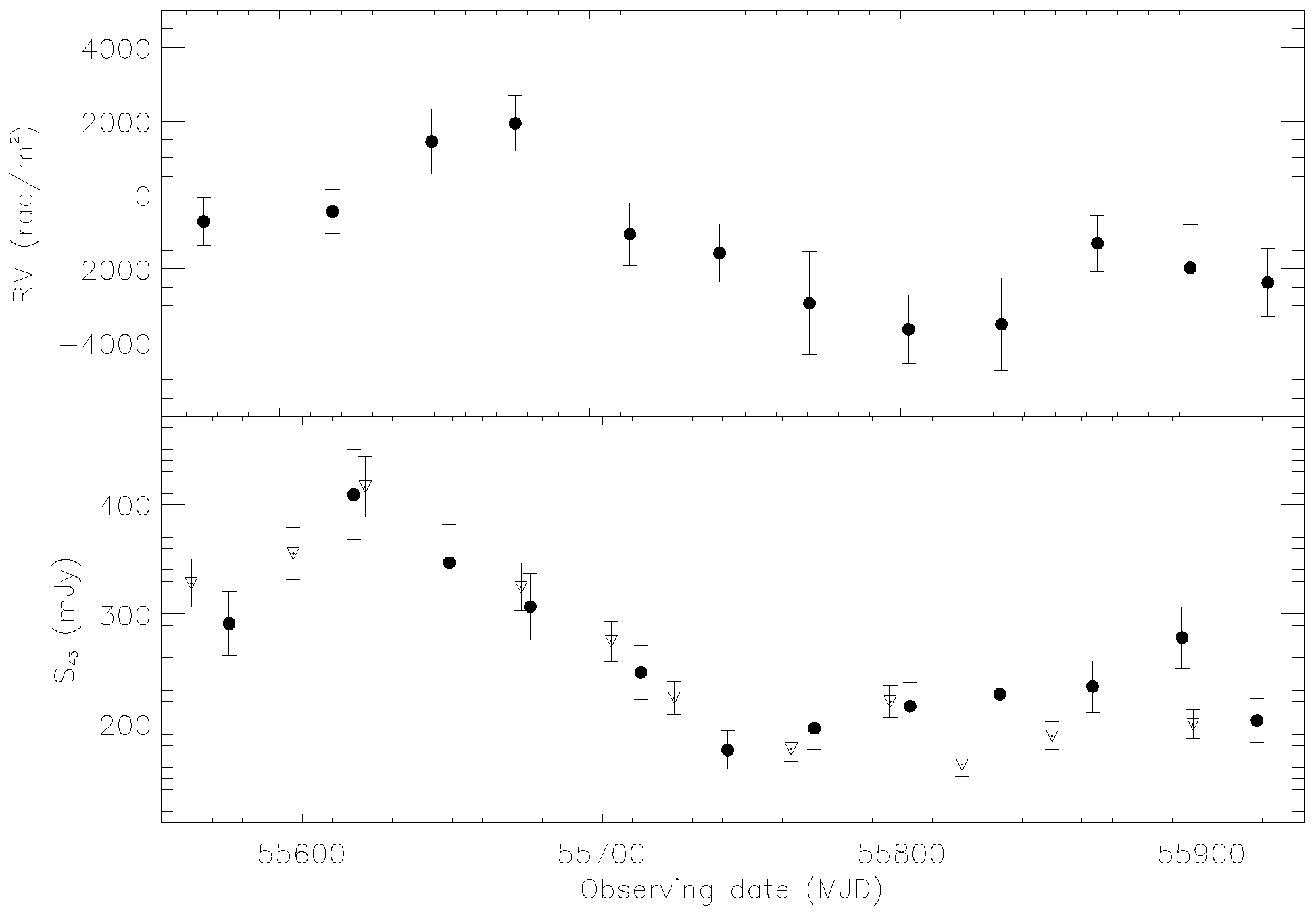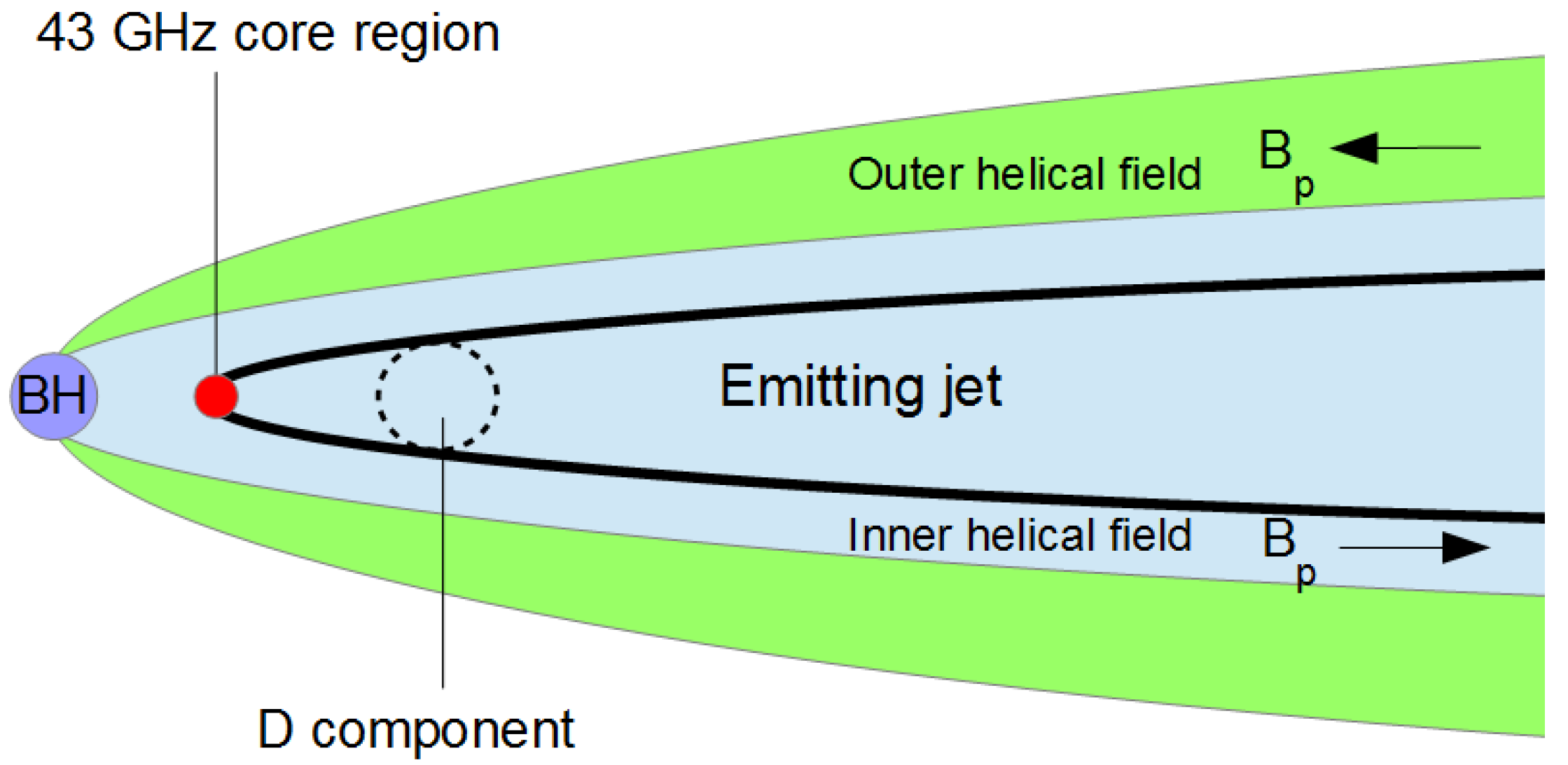On the Time Variable Rotation Measure in the Core Region of Markarian 421
Abstract
:1. Introduction
2. Results: RM and 43 GHz Flux Density Time Evolution
3. Discussion
3.1. Faraday Screen in the Accretion Flow
3.2. Faraday Screen in the Jet Sheath
4. Concluding Remarks
Acknowledgments
Author Contributions
Conflicts of Interest
References
- Gardner, F.F.; Whiteoak, J.B. The Polarization of Cosmic Radio Waves. Annu. Rev. Astron. Astrophys. 1966, 4, 245–292. [Google Scholar] [CrossRef]
- Zavala, R.T.; Taylor, G.B. A View through Faraday’s Fog: Parsec-Scale Rotation Measures in Active Galactic Nuclei. Astrophys. J. 2003, 589, 126–146. [Google Scholar] [CrossRef]
- Asada, K.; Nakamura, M.; Inoue, M.; Kameno, S.; Nagai, H. Multi-frequency Polarimetry toward S5 0836+710: A Possible Spine-Sheath Structure for the Jet. Astrophys. J. 2010, 720, 41–45. [Google Scholar] [CrossRef]
- Gómez, J.L.; Roca-Sogorb, M.; Agudo, I.; Marscher, A.P.; Jorstad, S.G. On the Source of Faraday Rotation in the Jet of the Radio Galaxy 3C 120. Astrophys. J. 2011, 733, 11. [Google Scholar] [CrossRef]
- Hovatta, T.; Lister, M.L.; Aller, M.F.; Aller, H.D.; Homan, D.C.; Kovalev, Y.Y.; Pushkarev, A.B.; Savolainen, T. MOJAVE: Monitoring of Jets in Active Galactic Nuclei with VLBA Experiments. VIII. Faraday Rotation in Parsec-scale AGN Jets. Astrophys. J. 2012, 144, 105. [Google Scholar] [CrossRef]
- Lico, R.; Giroletti, M.; Orienti, M.; Gómez, J.L.; Casadio, C.; D’Ammando, F.; Blasi, M.G.; Cotton, W.; Edwards, P.G.; Fuhrmann, L.; et al. Very Long Baseline polarimetry and the γ-ray connection in Markarian 421 during the broadband campaign in 2011. Astron. Astrophys. 2014, 571, A54–A66. [Google Scholar] [CrossRef]
- Gómez, J.L.; Lobanov, A.P.; Bruni, G.; Kovalev, Y.Y.; Marscher, A.P.; Jorstad, S.G.; Mizuno, Y.; Bach, U.; Sokolovsky, K.V.; Anderson, J.M.; et al. Probing the Innermost Regions of AGN Jets and Their Magnetic Fields with RadioAstron. I. Imaging BL Lacertae at 21 Microarcsecond Resolution. Astrophys. J. 2016, 817, 96. [Google Scholar] [CrossRef]
- Kravchenko, E.V.; Kovalev, Y.Y.; Sokolovsky, K.V. Parsec-scale Faraday rotation and polarization of 20 active galactic nuclei jets. Mon. Not. R. Astron. Soc. 2017, 467, 83–101. [Google Scholar] [CrossRef]
- Plambeck, R.L.; Bower, G.C.; Rao, R.; Marrone, D.P.; Jorstad, S.G.; Marscher, A.P.; Doeleman, S.S.; Fish, V.L.; Johnson, M.D. Probing the Parsec-scale Accretion Flow of 3C 84 with Millimeter Wavelength Polarimetry. Astrophys. J. 2014, 797, 66. [Google Scholar] [CrossRef]
- Asada, K.; Inoue, M.; Kameno, S.; Nagai, H. Time Variation of the Rotation Measure Gradient in the 3C 273 Jet. Astrophys. J. 2008, 675, 79–82. [Google Scholar] [CrossRef]
- O’Sullivan, S.P.; Gabuzda, D.C. Three-dimensional magnetic field structure of six parsec-scale active galactic nuclei jets. Mon. Not. R. Astron. Soc. 2009, 393, 429–456. [Google Scholar] [CrossRef]
- Asada, K.; Inoue, M.; Uchida, Y.; Kameno, S.; Fujisawa, K.; Iguchi, S.; Mutoh, M. A Helical Magnetic Field in the Jet of 3C 273. Publ. Astron. Soc. Jpn. 2002, 54, L39–L43. [Google Scholar] [CrossRef]
- Zavala, R.T.; Taylor, G.B. A View through Faraday’s Fog. II. Parsec-Scale Rotation Measures in 40 Active Galactic Nuclei. Astrophys. J. 2004, 612, 749–779. [Google Scholar] [CrossRef]
- Lico, R.; Giroletti, M.; Orienti, M.; Giovannini, G.; Cotton, W.; Edwards, P.G.; Fuhrmann, L.; Krichbaum, T.P.; Sokolovsky, K.V.; Kovalev, Y.Y.; et al. VLBA monitoring of Mrk 421 at 15 GHz and 24 GHz during 2011. Astron. Astrophys. 2012, 545, A117. [Google Scholar] [CrossRef]
- Blasi, M.G.; Lico, R.; Orienti, M.; Giovannini, G.; Giroletti, M.; Cotton, W.; Edwards, P.G.; Fuhrmann, L.; Krichbaum, T.P.; Sokolovsky, K.V.; et al. The TeV blazar Markarian 421 at the highest spatial resolution. Astron. Astrophys. 2013, 559, A75–A85. [Google Scholar] [CrossRef]
- Jones, T.W.; Odell, S.L. Transfer of polarized radiation in self-absorbed synchrotron sources. I. Results for a homogeneous source. Astrophys. J. 1977, 214, 522–539. [Google Scholar] [CrossRef]
- Wardle, J.F.C.; Homan, D.C. Theoretical Models for Producing Circularly Polarized Radiation in Extragalactic Radio Sources. Astrophys. Space Sci. 2003, 288, 143–153. [Google Scholar] [CrossRef]
- Celotti, A.; Kuncic, Z.; Rees, M.J.; Wardle, J.F.C. Thermal material in relativistic jets. Mon. Not. R. Astron. Soc. 1998, 293, 288–298. [Google Scholar] [CrossRef]
- Marrone, D.P.; Moran, J.M.; Zhao, J.-H.; Rao, R. Interferometric Measurements of Variable 340 GHz Linear Polarization in Sagittarius A. Astrophys. J. 2006, 640, 308–318. [Google Scholar] [CrossRef]
- Kuo, C.Y.; Asada, K.; Rao, R.; Nakamura, M.; Algaba, J.C.; Liu, H.B.; Inoue, M.; Koch, P.M.; Ho, P.T.P.; Matsushita, S.; et al. Measuring Mass Accretion Rate onto the Supermassive Black Hole in M87 Using Faraday Rotation Measure with the Submillimeter Array. Astrophys. J. Lett. 2014, 783, L33. [Google Scholar] [CrossRef]
- Narayan, R.; Yi, I. Advection-dominated accretion: A self-similar solution. Astrophys. J. 1994, 428, L13–L16. [Google Scholar] [CrossRef]
- Quataert, E.; Gruzinov, A. Convection-dominated Accretion Flows. Astrophys. J. 2000, 539, 809–814. [Google Scholar] [CrossRef]
- Lico, R.; Gómez, J.L.; Asada, K.; Fuentes, A. Interpreting the time variable RM observed in the core region of the TeV blazar Mrk 421. Mon. Not. R. Astron. Soc. 2017, 469, 1612–1616. [Google Scholar] [CrossRef]
- Lynden-Bell, D. Magnetic collimation by accretion discs of quasars and stars. Mon. Not. R. Astron. Soc. 1996, 279, 389–401. [Google Scholar] [CrossRef]
- Kato, Y.; Mineshige, S.; Shibata, K. Magnetohydrodynamic Accretion Flows: Formation of Magnetic Tower Jet and Subsequent Quasi-Steady State. Astrophys. J. 2004, 605, 307–320. [Google Scholar] [CrossRef]
- Contopoulos, I.; Kazanas, D. A Cosmic Battery. Astrophys. J. 1998, 508, 859–863. [Google Scholar] [CrossRef]
- Contopoulos, I.; Christodoulou, D.M.; Kazanas, D.; Gabuzda, D.C. The Invariant Twist of Magnetic Fields in the Relativistic Jets of Active Galactic Nuclei. Astrophys. J. Lett. 2009, 702, L148–L152. [Google Scholar] [CrossRef]
- Contopoulos, I.; Nathanail, A.; Sadowski, A.; Kazanas, D.; Narayan, R. Numerical simulations of the Cosmic Battery in accretion flows around astrophysical black holes. arXiv 2017, arXiv:1705.11021. [Google Scholar]
- Christodoulou, D.M.; Gabuzda, D.C.; Knuettel, S.; et al. Dominance of outflowing electric currents on decaparsec to kiloparsec scales in extragalactic jets. Astron. Astrophys. 2016, 591, A61–A71. [Google Scholar] [CrossRef]
- Mahmud, M.; Gabuzda, D.C.; Bezrukovs, V. Surprising evolution of the parsec-scale Faraday Rotation gradients in the jet of the BL Lac object B1803+784. Mon. Not. R. Astron. Soc. 2009, 400, 2–12. [Google Scholar] [CrossRef]
- Mahmud, M.; Coughlan, C.P.; Murphy, E.; Gabuzda, D.C.; Hallahan, D.R. Connecting magnetic towers with Faraday rotation gradients in active galactic nuclei jets. Mon. Not. R. Astron. Soc. 2013, 431, 695–709. [Google Scholar] [CrossRef]
- Gómez, J.L.; Marti, J.M.A.; Marscher, A.P.; Ibanez, J.M.A.; Marcaide, J.M. Parsec-Scale Synchrotron Emission from Hydrodynamic Relativistic Jets in Active Galactic Nuclei. Astrophys. J. Lett. 1995, 449, L19. [Google Scholar] [CrossRef]
- Gómez, J.L.; Martí, J.M.; Marscher, A.P.; Ibáñez, J.M.; Alberdi, A. Hydrodynamical Models of Superluminal Sources. Astrophys. J. Lett. 1997, 482, L33–L36. [Google Scholar] [CrossRef]
- Fromm, C.M.; Perucho, M.; Mimica, P.; Ros, E. Spectral evolution of flaring blazars from numerical simulations. Astron. Astrophys 2016, 588, A101–A115. [Google Scholar] [CrossRef]
- Broderick, A.E.; Loeb, A. Signatures of Relativistic Helical Motion in the Rotation Measures of Active Galactic Nucleus Jets. Astrophys. J. Lett. 2009, 703, L104–L108. [Google Scholar] [CrossRef]
- Deller, A.T.; Brisken, W.F.; Phillips, C.J.; Morgan, J.; Alef, W.; Cappallo, R.; Middelberg, E.; Romney, J.; Rottmann, H.; Tingay, S.J.; et al. DiFX-2: A More Flexible, Efficient, Robust, and Powerful Software Correlator. Publ. Astron. Soc. Pac. 2011, 123, 275. [Google Scholar] [CrossRef]
| 1 |


© 2017 by the authors. Licensee MDPI, Basel, Switzerland. This article is an open access article distributed under the terms and conditions of the Creative Commons Attribution (CC BY) license (http://creativecommons.org/licenses/by/4.0/).
Share and Cite
Lico, R.; Gómez, J.L.; Asada, K.; Fuentes, A. On the Time Variable Rotation Measure in the Core Region of Markarian 421. Galaxies 2017, 5, 57. https://doi.org/10.3390/galaxies5040057
Lico R, Gómez JL, Asada K, Fuentes A. On the Time Variable Rotation Measure in the Core Region of Markarian 421. Galaxies. 2017; 5(4):57. https://doi.org/10.3390/galaxies5040057
Chicago/Turabian StyleLico, Rocco, José L. Gómez, Keiichi Asada, and Antonio Fuentes. 2017. "On the Time Variable Rotation Measure in the Core Region of Markarian 421" Galaxies 5, no. 4: 57. https://doi.org/10.3390/galaxies5040057






